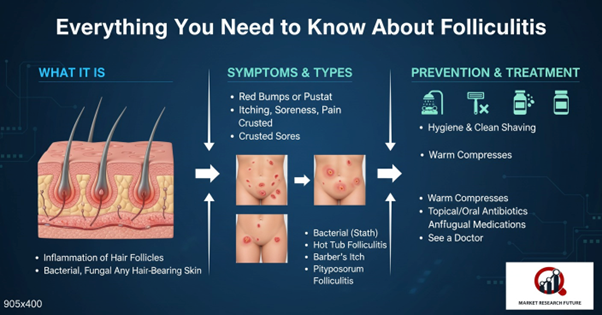Everything You Need to Know About Folliculitis

The Introduction to the Folliculitis Market
The adoption of advanced dermatological treatments is creating new opportunities for folliculitis. The size of the global folliculitis market is projected to change from USD 1.99 billion in 2024 to USD 3.77 billion by 2035. The development of the sector will occur at a comfortable pace, adhering to a moderate CAGR of 5.8% through the forecast period.
Folliculitis is a common skin condition characterized by inflammation of hair follicles. It can be acute or chronic, and may present as non-purulent (without pus) or purulent (with pus formation).
This condition is often triggered by bacterial, fungal, or parasitic infections. Factors such as immune deficiency, certain medications, or excessive sweating can increase susceptibility, particularly in areas like the head and buttocks.
Causes of Folliculitis
Folliculitis can arise from infectious and non-infectious causes:
- Infectious Causes:
- Non-infectious Causes:
- Bacteria:Staphylococcus aureus is the most common culprit. Normally present on the skin, it can infect hair follicles when the skin is damaged or the immune system is weakened.
- Fungi: Dermatophytes can lead to fungal folliculitis.
- Viruses: Herpes simplex virus can cause viral folliculitis.
- Parasites: Certain mites can trigger parasitic folliculitis.
- Medications such as steroids and tyrosine kinase inhibitors (used in cancer therapy).
- Hair growth disorders or abnormal keratinization of the skin.
- Immunodeficiency, whether congenital or caused by immunosuppressive drugs.
Symptoms of Folliculitis
Folliculitis presents with the classic signs of inflammation: redness, swelling, heat, and tenderness.
Typical features include:
- Pustules surrounding a single hair follicle.
- Crust formation and scarred healing in some forms, leading to hairless patches.
- Additional scaling in fungal infections.
- Pain or discomfort, especially if the folliculitis is recurrent or severe.
Severe folliculitis may progress to boils (abscesses). Diagnosis is usually visual, but repeated or atypical cases may require further evaluation for systemic conditions like diabetes or immunodeficiency. Occasionally, a biopsy may be necessary.
Management and Prevention
- Personal hygiene: Keeping the skin clean and dry is crucial, particularly in moist areas.
- Topical treatments: Antibacterial or antifungal creams, depending on the cause.
- Systemic therapy: In severe or recurrent cases, oral antibiotics or antifungal medications may be required.
- Lifestyle adjustments: Avoid tight clothing, reduce friction, and manage excessive sweating.
Regional Analysis
The prevalence and management of folliculitis vary across regions due to climate, healthcare access, and hygiene practices. In tropical and subtropical regions, higher humidity and heat increase the risk of folliculitis, particularly bacterial and fungal types.
Developed countries with widespread access to dermatological care report more diagnoses due to routine check-ups, while developing nations may see underreported cases.
Urban areas, where close contact and sweating are more common, show higher incidence rates compared to rural areas. Preventive measures such as education on personal hygiene and the availability of topical treatments are critical in controlling folliculitis globally.

Leave a Comment